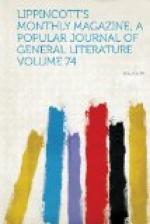The enjoyment of the evening is at high pressure. The dancers are swinging, surging, spinning through the Spanish dance. Everybody who can find a partner and a place on the floor—there are many who cannot find the latter—is dancing. It is a gay, a brilliant scene. All is going as merrily as a whole chime of marriage-bells when a deep and solemn peal from the church close by breaks in over the music, the laughter and the dancing. It is midnight! It is the Noche Buena, and the bell summons the faithful to the midnight mass. The effect is electric. The last twirl of the waltz is suspended, half executed. The dancers stop as suddenly as if they were puppets moved and stilled by the cunning of some wire-pulling hand. A general rush is made for the church: in a moment the ball-room is empty. The church is filled as instantaneously, and the wildly gay dancers of a moment ago are now kneeling, hushed and down-bent, in devotional attitudes.
The scene is impressive: the bright ball-toilettes contrasted in a “dim religious light,” the sudden change of place and mood, from gay to grave, from ball-room to sanctuary, strikes a stranger’s eye with thrilling effect. At the conclusion of the service the dancers return to the ball-room, to change from grave to gay, and dance ad libitum till daylight.
J.T.
ENGLISH BIBLE TRANSLATIONS.
The first complete translation of the Bible into our language was made about the year 1380 by John de Wycliffe, or Wickliffe. There are several manuscript copies of it in the Bodleian and other European libraries. This great work unlocked the Scriptures to the multitude, or, as one of his antagonists, bewailing such an enterprise, worded it, “the gospel pearl was cast abroad and trodden under foot.” Long before the appearance of this translation various versions of portions of the Bible had appeared, specimens of which, of every century from the reign of Alfred to Chaucer’s time, are preserved in the British Museum and elsewhere. Sir Thomas More says: “The Holy Byble was longe before Wycliffis daies by virtuose and well-learned




